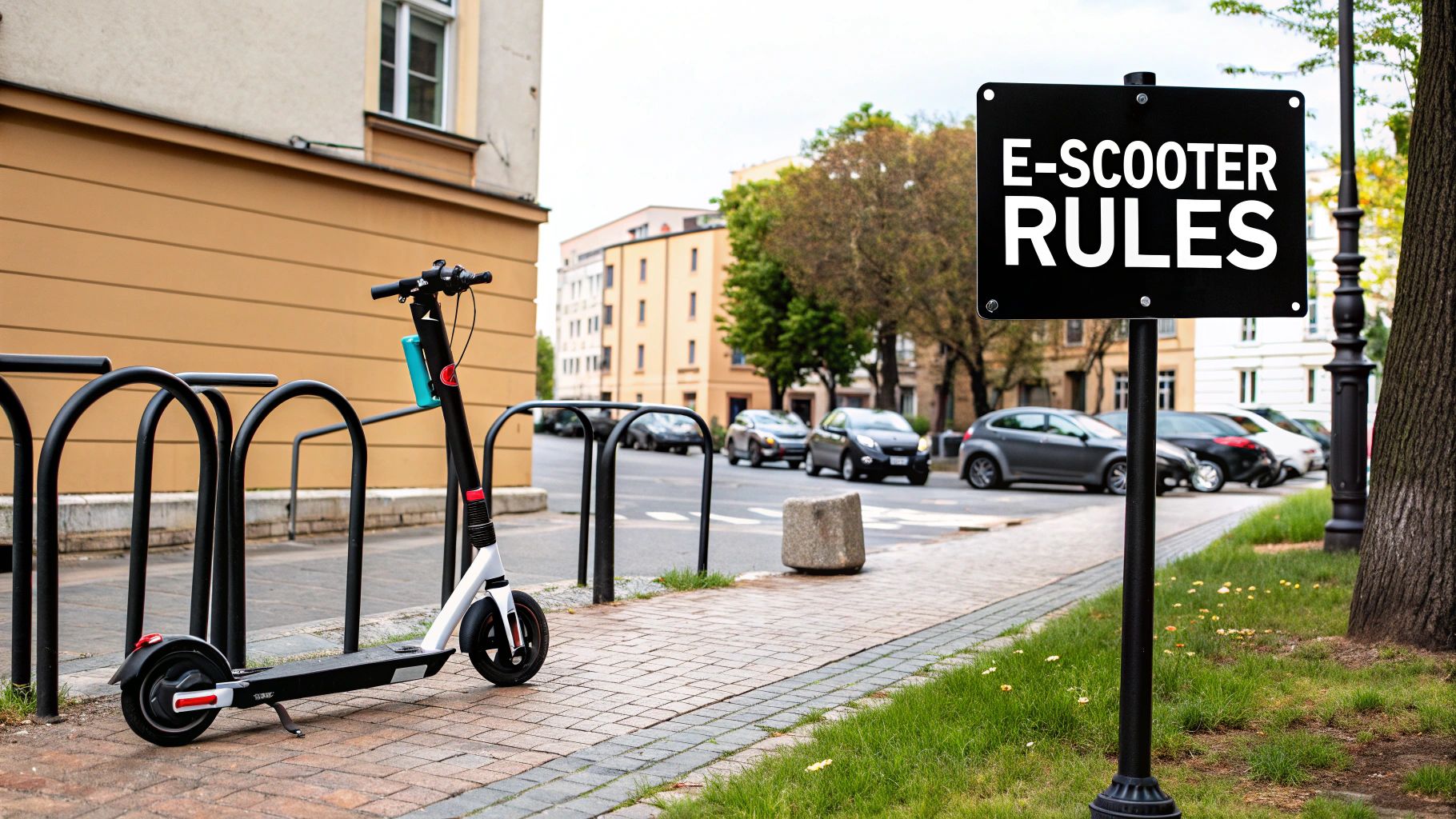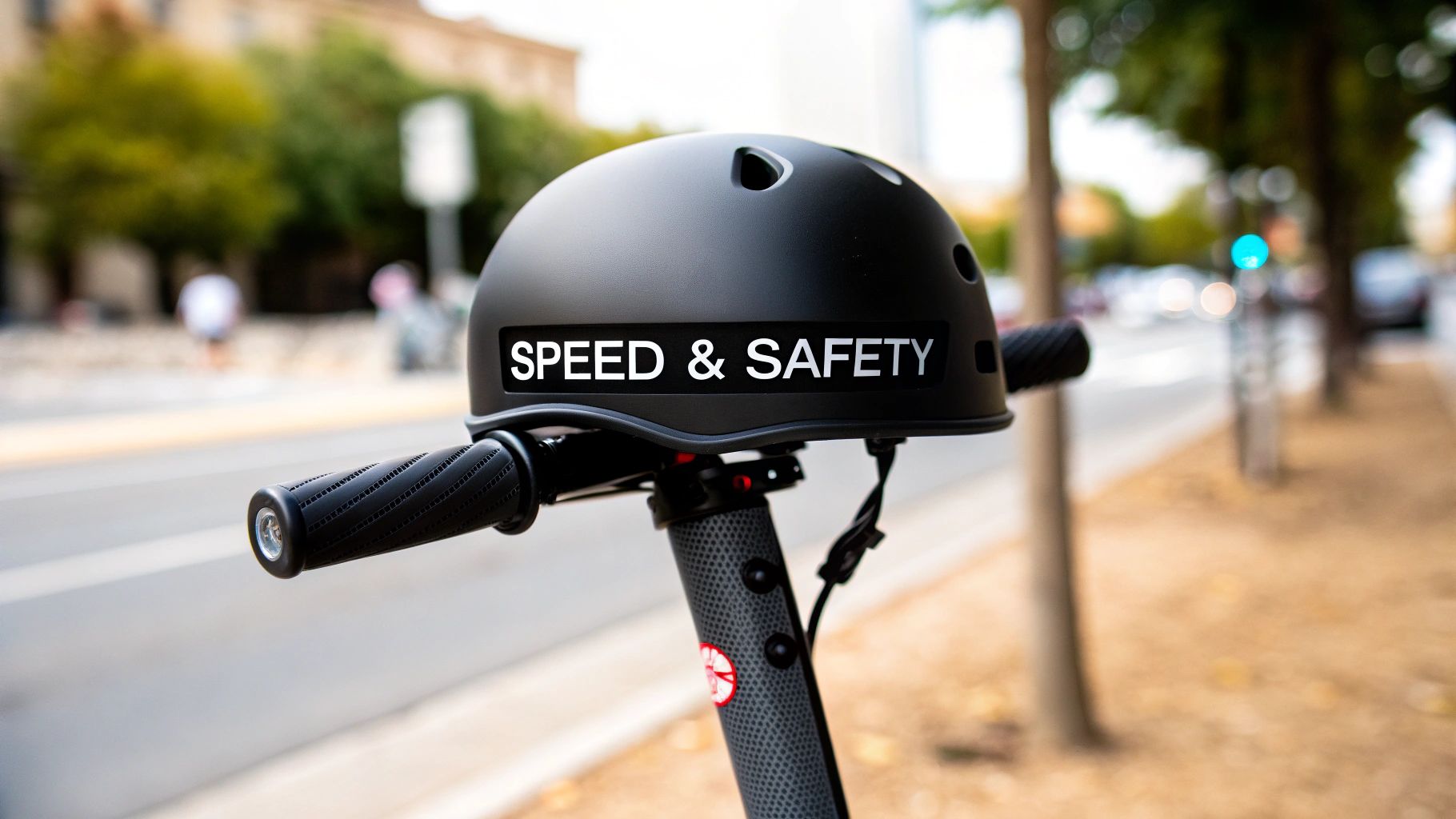Riding an electric scooter through the California sunshine is an awesome way to get around, but you can't just hop on and go. The state has a specific set of rules for e-scooter riders. The big ones? You need to be at least 16, have a driver's license (or permit), keep your speed under 15 mph, and—this is a big one—stay off the sidewalks.
Your Guide to California E-Scooter Rules

Trying to figure out all the e-scooter regulations can feel like a real headache, but knowing the basics is crucial for a safe—and legal—ride. The Golden State put together a clear framework to manage these popular two-wheelers, making sure they fit into the flow of traffic. It's best to think of these laws less like restrictions and more like the rules of the road that protect you, pedestrians, and drivers.
This guide will break down the legal stuff into plain English. We’ll cover the essential statewide rules that every rider needs to know. From who can ride to where you can go, this is everything you need to cruise with confidence.
The Foundation of Statewide Regulations
California’s e-scooter laws didn't just appear out of nowhere. They were a direct response to the explosion of shared scooters from companies like Bird and Lime. To manage the initial free-for-all, the state put official regulations into the vehicle code, creating a consistent baseline for everyone from San Diego to Sacramento.
The main state law is California Vehicle Code § 21235. It lays out the most important rules: you have to be at least 16 years old and hold a valid driver’s license or a learner’s permit. Your top speed is legally capped at 15 miles per hour. For the most part, you'll need to stick to bike lanes or roads where the speed limit is 25 mph or less.
The whole point of these statewide laws is to create predictability. When every rider follows the same fundamental rules, it makes the roads safer for everyone involved.
For a quick rundown of the most important rules, check out this table.
California E-Scooter Laws At a Glance
Here’s a quick summary of the most important statewide electric scooter regulations you need to know before you ride.
| Regulation | What You Need to Know |
|---|---|
| Minimum Age | You must be at least 16 years old to ride. |
| Driver's License | A valid driver's license or learner's permit is required. |
| Helmet Law | All riders under the age of 18 must wear a helmet. |
| Speed Limit | The maximum speed is 15 mph, regardless of the posted speed limit. |
| Where to Ride | Stick to Class II or Class IV bike lanes whenever possible. |
| Sidewalks | Riding on the sidewalk is strictly prohibited statewide. |
| Passengers | No passengers allowed. One rider per scooter, period. |
| DUI | You can get a DUI for riding an e-scooter under the influence. |
Remember, this table covers the rules that apply everywhere in California. Your local city might have even more specific regulations.
Why State Laws Are Just the Beginning
While the state law sets the ground rules, it’s not the final word. Think of it as the foundation. Many cities and counties across California have built on top of it by adding their own local ordinances.
These local rules can cover things like where you can park, whether there are curfews for scooter rentals, or even specific "no-ride zones" in busy downtown areas or on boardwalks. This means that while the core rules are the same everywhere, the day-to-day experience can change from one city to the next. For a complete picture of micromobility regulations, check out our comprehensive guide on electric scooter laws by state.
Who's Actually Allowed to Ride an E-Scooter?
Before you jump on the nearest electric scooter and zip off, let's talk about who can legally ride one in California. The state has some very clear rules in place, and they're not just suggestions.
Think of it this way: California sees these scooters as vehicles, not toys. That means they come with real responsibilities. The two biggest hurdles you need to clear are age and having a driver's license.
You Must Be at Least 16
First thing's first: you have to be at least 16 years old to legally ride an e-scooter on any public road, bike path, or bikeway. This isn't a rule made up by rental companies like Bird or Lime; it's straight from the California Vehicle Code.
Why 16? It really comes down to safety and judgment. The law assumes that riders under this age might not have the quick reflexes or traffic awareness needed to handle a motorized vehicle safely. It’s a serious rule designed to protect not just the rider, but everyone else on the road.
This is a big one for parents to understand. If a rider under 16 causes an accident, their parents can be held legally and financially responsible for any damages or injuries. It's not just a slap on the wrist.
This age minimum is a cornerstone of the electric scooter law California has in place to keep things from getting chaotic.
Yep, You Need a Driver's License or Permit
This is the rule that catches a lot of people by surprise. On top of being old enough, you absolutely must have a valid driver's license or a learner's permit to ride an e-scooter in California.
You don't need a special motorcycle license or anything fancy. All you need is one of the following:
- A standard Class C driver's license
- Any other valid class of driver's license
- A learner's permit (also called an instruction permit)
The logic here is pretty simple: having a license or permit proves you’ve at least passed a basic test on the rules of the road. It means you should know what a stop sign means and who has the right-of-way.
Interestingly, even with a learner's permit, a 16-year-old can legally ride an e-scooter all by themselves—a key difference from the rules for driving a car.
Where You Can (and Can't) Legally Ride
Figuring out exactly where you're allowed to ride your electric scooter can be the trickiest part of staying on the right side of the law. The rules aren't always posted on a giant sign, but they’re there to keep traffic flowing and everyone safe—riders, pedestrians, and drivers.
Let’s break down the "ride zones" so you can cruise around California without any trouble.
The biggest rule to burn into your memory is the statewide ban on riding on the sidewalk. This one’s a non-negotiable part of the electric scooter law California takes very seriously. Sidewalks are strictly for pedestrians, and zipping down one on your scooter is a quick way to get a ticket. It's best to think of your scooter as a vehicle that belongs on the road, not on the pavement with people walking.
This infographic gives a great visual of where you should be to stay safe and legal.
As you can see, the goal is to keep scooters in their own lane, away from both fast-moving cars and people on foot.
Stick to the Bike Lane
The bike lane is your home base. Seriously. California Vehicle Code § 21229 makes it clear: if there’s a Class II or Class IV bikeway available, you need to be in it. These are the lanes you see marked with white lines and a bicycle symbol, running right alongside traffic.
Using the bike lane is always your safest and most legal bet. But the law is reasonable and allows for a few exceptions where you can pop out of the lane for a moment:
- When you’re about to make a left turn at an intersection.
- When you need to safely pass another rider, a cyclist, or a pedestrian.
- To get around debris or other hazards blocking your path.
- As you're making a right-hand turn.
Riding on Public Roads
So, what happens when there's no bike lane in sight? You can ride on the street, but there’s a catch: it has to be a road with a posted speed limit of 25 mph or less. When you're on these streets, you need to ride as close to the right-hand curb as you safely can.
This rule is all about safety. It keeps slower-moving scooters from mixing with fast-moving traffic, which is a recipe for disaster. Never, ever ride your scooter on a street with a speed limit over 25 mph unless there’s a bike lane you can use.
The core idea is simple: match the flow of your environment. If traffic is slow, you can join it. If it’s fast, you need a protected space like a bike lane.
Local Rules Can Add Another Layer
While state laws set the baseline, always remember that cities can—and do—add their own rules to the mix. For example, a city like San Diego might ban scooters entirely on its packed boardwalks, while San Francisco might require you to park shared scooters in designated corrals. What’s perfectly legal in one town could get you a fine in the next.
And they are definitely enforcing these rules, especially the sidewalk ban. Just look at the numbers: between January and mid-July of 2018, the LAPD handed out around 800 citations for over 900 violations, with most of those tickets written for riding on sidewalks. You can read more about the rise in scooter citations from the Los Angeles Times.
Bottom line: always check for local signs or look at your rental app for any extra rules that apply to the specific area you're riding in.
Mastering Speed Limits and Safety Gear

Alright, so you know where you can ride, but what about how you ride? This is where the rules for speed and safety gear come in, and they're a huge deal. Sticking to California's electric scooter laws isn't just about dodging a ticket—it’s about keeping yourself (and everyone else) safe out there. These aren't just arbitrary suggestions; they're firm rules based on a lot of real-world data.
First up, let's talk speed. California has a statewide speed limit for all electric scooters: 15 miles per hour. That's the max, no matter where you are—a street, a bike path, anywhere. It doesn't matter if the speed limit for cars is 35 mph; for you on a scooter, it's still 15 mph. If you're curious about the "why" behind this specific number, we break it all down in our guide where you can learn more about electric scooter speed limits.
The Helmet Rule Explained
California’s helmet law is pretty simple and breaks down by age. If you’re under 18, you absolutely have to wear a properly fastened bicycle helmet. No exceptions. For riders 18 and over, the law doesn't require it, but honestly, it's a really good idea.
Riding without a helmet when you're supposed to is an easy way to get a ticket, which can set you back around $200. But more importantly, it puts you at serious risk in a crash. It's a simple piece of gear that can literally save your life.
Think of a helmet as your personal seatbelt for a scooter. While it might feel like a minor inconvenience, it's the single most effective piece of safety equipment you can use to protect yourself from a head injury.
Essential Gear and Operational Rules
Beyond speed and helmets, a few other operational rules are just as important for staying safe and legal. These regulations make sure you're visible and are handling the scooter the way it was meant to be handled.
Here are the key safety must-dos:
- No Passengers Allowed: Scooters are strictly a one-person ride. It's illegal to carry a passenger, and it makes the scooter incredibly unstable and hard to control.
- Lights for Night Riding: If you're out after dark, your scooter needs lights. We're talking a white headlight visible from 300 feet away and a red rear reflector that can be seen from 500 feet.
- Keep a Hand on the Handlebars: You need to keep at least one hand on the handlebars at all times. It sounds like common sense, but it’s a rule for a reason—you need to stay in control.
These laws are direct responses to accident prevention. As scooters have gotten more popular, injuries have unfortunately shot up too. Data from Southern California revealed that after shared e-scooters hit the streets, injuries went from being a rarity to 672 in 2019 alone. That works out to an estimated injury rate of 115 injuries per 1 million trips. It's a sobering reminder of why these rules exist. You can discover more insights about California e-scooter accident statistics to get a clearer picture of the risks.
Avoiding Common Fines and Penalties
https://www.youtube.com/embed/LNudMGC_bFQ
Knowing the rules is one thing, but seeing how they play out in the real world is what makes them stick. Let’s be honest, ignoring California's e-scooter laws isn't just a safety risk—it can hit your wallet, and hard. These aren't just minor slaps on the wrist; a single ticket can easily turn a cheap ride into a very expensive mistake.
This isn't to scare you, but to help you ride smarter. Once you know the common mistakes that trip people up, you can cruise with total confidence, knowing you're keeping yourself safe and your record clean.
The Real Cost of a Ticket
When you get a ticket for an e-scooter violation, the price on the ticket is rarely what you end up paying. After court fees and other administrative charges get piled on, a minor infraction can quickly swell into hundreds of dollars. The fines are designed to be a serious deterrent, not just a nuisance.
Here are a few of the most common violations and a ballpark of what they might cost you:
- Riding on the Sidewalk: This is probably the number one ticket riders get. It’s a violation of CVC § 21235(g), and you can expect a fine hovering around $200.
- No Helmet (Under 18): If you're under 18 and caught without a helmet, that's another ticket that often costs about $200.
- Exceeding 15 MPH: Pushing your scooter past the 15 mph speed limit can get you a ticket worth up to $250.
- Riding Without a License: Hopping on a scooter without a valid driver's license or permit is a big one, and it comes with a hefty fine to match.
As you can see, a few bad decisions can turn a fun, convenient ride into a major financial headache.
Common Mistakes and How to Sidestep Them
Most tickets aren't for some obscure, buried rule; they're for the basic stuff riders tend to forget or just ignore. The biggest offender, by far, is riding on the sidewalk. I get it, it feels safer when you're in heavy traffic, but it’s illegal everywhere in California and police are always on the lookout for it because of the danger it poses to pedestrians.
The simplest way to stay out of trouble is to think like a cyclist. Stick to the bike lane whenever one is available, obey all the traffic signals, and never, ever assume you have the right-of-way. Just treat your scooter like the vehicle it is, not like a toy.
Another frequent mistake is messing up a left turn. The law, specifically CVC § 21228, has a very particular way you’re supposed to do it. You need to ride to the far-right corner of the intersection, get off your scooter, and walk it across the street just like a pedestrian would. It feels a little clumsy at first, but it's the law for a reason—it keeps you from getting hit.
By just focusing on these key things—staying off sidewalks, wearing a helmet, watching your speed, and making proper turns—you'll easily avoid the vast majority of tickets handed out under the electric scooter law in California.
Common Questions About California Scooter Laws
Even when you know the basics, real-world situations can get tricky. California's electric scooter laws have some nuances that can leave you wondering what to do. Let's tackle some of the most common questions people ask so you have clear, straightforward answers.
Think of this as your go-to guide for those "what if" moments on the road. We'll cover everything from insurance and DUIs to what to do if you get into a crash.
Do I Need Insurance to Ride an E-Scooter?
Officially, no. The state of California doesn't require you to carry a special insurance policy just to ride an electric scooter. But this is a classic case of what’s legal versus what’s smart.
While you don't need a policy to be street-legal, you could be on the hook personally for any damages or injuries if you cause an accident. Your homeowner's or renter's insurance might offer some liability coverage, but be careful—many policies specifically exclude incidents involving motorized vehicles. It's really important to read the fine print.
If you own your scooter, getting a separate mobility device or scooter insurance policy is your safest bet. For rentals from companies like Lime or Bird, they usually include some basic insurance, but relying only on their coverage in a serious accident can be a huge risk.
Can I Get a DUI on an E-Scooter?
Yes, absolutely. This is one of the most serious and misunderstood parts of California's e-scooter rules. The California Vehicle Code treats an electric scooter just like any other motorized vehicle when it comes to driving under the influence.
That means you can be stopped, tested, and arrested for a DUI while riding an e-scooter if you're impaired by alcohol or drugs. The penalties are just as severe as getting a DUI in a car—we're talking thousands of dollars in fines, a suspended driver's license, and even jail time.
There’s zero tolerance here. The only safe and legal choice is to ride sober.
What Should I Do After an E-Scooter Accident?
If you're in an accident, your first priority is safety. Get yourself and the scooter out of traffic if you can, and immediately check for injuries on yourself and anyone else involved. If someone is hurt, call 911 right away.
After that, handle it just like a car crash:
- Exchange Information: Get the names, contact info, license details, and insurance from anyone else involved, whether they're a driver or a pedestrian.
- Document Everything: Use your phone to take pictures of the scene, vehicle damage, road conditions, and any injuries. The more photos, the better.
- Look for Witnesses: If anyone saw what happened, politely ask for their name and number. Their story could be a huge help later on.
- File a Police Report: Always ask for a police report. It creates an official, unbiased record of what happened.
- Report to the Rental Company: If you were on a shared scooter, make sure to report the accident through their app as soon as it's safe to do so.
Following these steps helps protect you legally and financially. To be even more prepared, check out these essential electric scooter safety tips to help you avoid accidents altogether.
Are Rules Different for Shared and Personal Scooters?
For the most part, no. The main statewide laws apply to every electric scooter out there, whether you own it yourself or are just renting it from an app.
That means the big rules are the same for everyone:
- The 15 mph speed limit.
- Helmets are required for all riders under 18.
- No riding on sidewalks, period.
- You must have a valid driver's license or instruction permit.
The differences usually pop up at the local level. A city might create "no-parking zones" for shared scooters to keep sidewalks clear, or a rental app might have geofenced areas where you can't end your ride. Always follow state law first, but it pays to check the app for any extra local rules.
At Punk Ride, we believe that riding should be simple, fun, and safe. We offer a wide selection of top-tier electric scooters and bikes from trusted brands to ensure you have a high-quality ride every time. Find your perfect ride and explore your city with confidence by visiting us at https://www.punkride.com.





Share:
A Guide to Electric Scooter Laws By State
Your Guide to All Terrain Electric Scooters